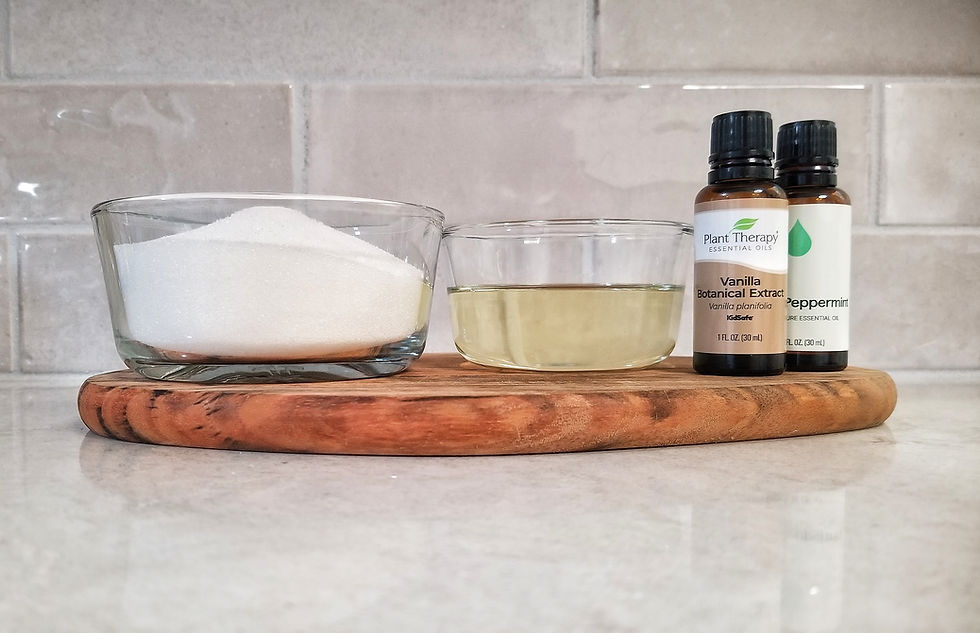Inhalation of Essential Oils: Benefits, Methods, and Precautions
- Jean McCabe
- Jun 19
- 4 min read
Aromatic Healing for Mind and Body
Essential oils, extracted from plants, have been revered for centuries for their therapeutic properties. Among the various ways of using essential oils, inhalation is one of the most effective and accessible methods. This practice has grown increasingly popular as people seek natural remedies to enhance well-being and mental clarity. This document explores the benefits, methods, and precautions associated with the inhalation of essential oils.
Olfaction AKA sense of smell is a powerful sense, it is one of our primary senses. The scent of a flower, freshly baked apple pie or a perfume can take us on a journey to our memories or emotions of spring, our Momma's kitchen or maybe our first love.
Inhaling essential oils stimulates the olfactory system, the part of the brain connected to smell, including the nose and the brain. As the molecules reach the brain, they affect limbic system, which is linked to the emotions, the heart rate, blood pressure, breathing, memory, stress, and hormone balance. In this way, essential oils can have a subtle, yet holistic effect on the body.

Benefits of Inhalation of Essential Oils
Inhaling essential oils allows their aromatic molecules to travel directly to the brain, particularly targeting the limbic system, which plays a key role in emotions, memory, and behavior. Here are some key benefits:
· Stress Relief: Scents like lavender, chamomile, and bergamot are known to reduce stress and promote relaxation.
· Improved Sleep: Essential oils such as lavender, bergamot or sandalwood can help combat insomnia and improve sleep quality.
· Enhanced Focus: Oils like rosemary, peppermint, and lemon are known to boost concentration and mental clarity.
· Respiratory Support: Eucalyptus and tea tree oils can clear nasal congestion and support respiratory health.
· Elevated Mood: Citrus oils such as orange and grapefruit are uplifting and can alleviate symptoms of mild depression.
Methods of Inhalation
There are several methods to inhale essential oils, each catering to different preferences and needs. Here are the most common ones:
1. Direct Inhalation
This is the simplest technique, where you inhale the aroma directly from the bottle or a tissue. Simply hold the bottle a few inches away from your nose and take deep breaths. Alternatively, place a few drops of oil on a tissue or cotton pad and inhale.
2. Steam Inhalation
Steam inhalation is particularly effective for respiratory issues. Add a few drops of essential oil to a bowl of hot water, lean over it, and cover your head with a towel to trap the steam. Breathe deeply for several minutes, ensuring your eyes are closed to avoid irritation.
3. Diffusers
Diffusers disperse essential oils into the air, creating a fragrant and therapeutic atmosphere. Ultrasonic diffusers, which use water and vibrations to release a mist, are a popular and safe choice for home use. Reed diffusers and nebulizing diffusers are alternative options that cater to different aesthetics and needs.
4. Aromatherapy Inhalers
Small and portable, aromatherapy inhalers are cylindrical devices filled with essential oils. They are perfect for on-the-go use, allowing you to benefit from aromatherapy wherever you are.
Precautions to Keep in Mind
While inhalation of essential oils is generally safe, some precautions are necessary to ensure a positive and safe experience:
· Choose High-Quality Oils: Always opt for pure essential oils. Low-quality oils may contain additives or chemicals that can be harmful.
· Test for Sensitivity: Before use, test the oil by inhaling briefly to ensure you don’t experience adverse reactions such as headaches or nausea.
· Moderation is Key: Overexposure to essential oils can lead to headaches or respiratory irritation. Use them in small amounts and avoid extended inhalation periods.
· Consult a Professional: If you are pregnant, nursing, or have medical conditions, consult a healthcare provider before using essential oils.
· Ventilation: When diffusing oils, ensure the room is well-ventilated to avoid overwhelming the senses.
Popular Essential Oils for Inhalation
Here’s a list of some widely used essential oils and their unique properties:
· Lavender: Known for its calming effect, lavender is ideal for stress relief and sleep enhancement.
· Peppermint: A favorite for boosting energy, reducing nausea, and improving focus.
· Eucalyptus: Popular for respiratory health, it helps clear sinuses and ease breathing.
· Lemon: A citrusy oil that uplifts the mood and improves concentration.
· Frankincense: Known for its grounding and balancing effects, often used in meditation practices.
Conclusion
The inhalation of essential oils offers a natural and effective way to enhance physical and emotional well-being. Whether you are seeking relaxation, mental clarity, or respiratory relief, aromatherapy can be tailored to your needs. By selecting high-quality oils, employing safe methods, and following recommended precautions, you can enjoy the countless benefits these aromatic wonders provide. As always, remember that moderation and mindfulness are the keys to a positive experience. Dive into the world of essential oils and let their aromatics transform your life.
This week I will be covering more on inhalation therapy and essential oil inhalers so stop back for more information.




Thanks so much. That was interesting and helpful